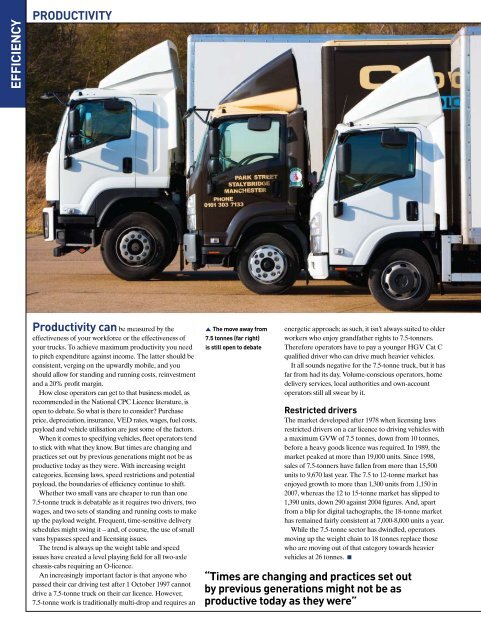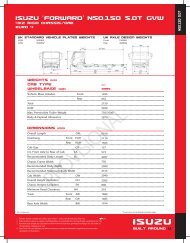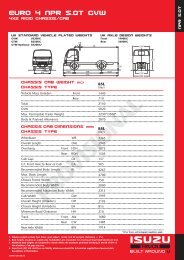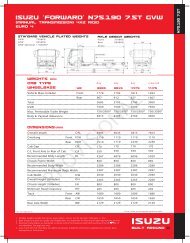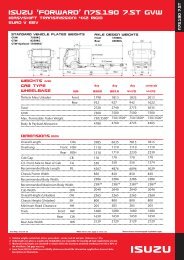ISUZU LAID BARE - Isuzu Trucks
ISUZU LAID BARE - Isuzu Trucks
ISUZU LAID BARE - Isuzu Trucks
Create successful ePaper yourself
Turn your PDF publications into a flip-book with our unique Google optimized e-Paper software.
EffICIENCY<br />
PRODUCTIVITY<br />
Productivity can be measured by the ▲ The move away from energetic approach; as such, it isn’t always suited to older<br />
effectiveness of your workforce or the effectiveness of 7.5 tonnes (far right) workers who enjoy grandfather rights to 7.5-tonners.<br />
your trucks. To achieve maximum productivity you need is still open to debate Therefore operators have to pay a younger HGV Cat C<br />
to pitch expenditure against income. The latter should be qualifed driver who can drive much heavier vehicles.<br />
consistent, verging on the upwardly mobile, and you It all sounds negative for the 7.5-tonne truck, but it has<br />
should allow for standing and running costs, reinvestment far from had its day. Volume-conscious operators, home<br />
and a 20% proft margin. delivery services, local authorities and own-account<br />
How close operators can get to that business model, as operators still all swear by it.<br />
recommended in the National CPC Licence literature, is<br />
open to debate. So what is there to consider? Purchase Restricted drivers<br />
price, depreciation, insurance, VED rates, wages, fuel costs, The market developed after 1978 when licensing laws<br />
payload and vehicle utilisation are just some of the factors. restricted drivers on a car licence to driving vehicles with<br />
When it comes to specifying vehicles, feet operators tend a maximum GVW of 7.5 tonnes, down from 10 tonnes,<br />
to stick with what they know. But times are changing and before a heavy goods licence was required. In 1989, the<br />
practices set out by previous generations might not be as market peaked at more than 19,000 units. Since 1998,<br />
productive today as they were. With increasing weight sales of 7.5-tonners have fallen from more than 15,500<br />
categories, licensing laws, speed restrictions and potential units to 9,670 last year. The 7.5 to 12-tonne market has<br />
payload, the boundaries of effciency continue to shift. enjoyed growth to more than 1,300 units from 1,150 in<br />
Whether two small vans are cheaper to run than one 2007, whereas the 12 to 15-tonne market has slipped to<br />
7.5-tonne truck is debatable as it requires two drivers, two 1,390 units, down 290 against 2004 fgures. And, apart<br />
wages, and two sets of standing and running costs to make from a blip for digital tachographs, the 18-tonne market<br />
up the payload weight. Frequent, time-sensitive delivery has remained fairly consistent at 7,000-8,000 units a year.<br />
schedules might swing it – and, of course, the use of small While the 7.5-tonne sector has dwindled, operators<br />
vans bypasses speed and licensing issues. moving up the weight chain to 18 tonnes replace those<br />
The trend is always up the weight table and speed who are moving out of that category towards heavier<br />
issues have created a level playing feld for all two-axle vehicles at 26 tonnes. ■<br />
chassis-cabs requiring an O-licence.<br />
An increasingly important factor is that anyone who “Times are changing and practices set out<br />
passed their car driving test after 1 October 1997 cannot by previous generations might not be as<br />
drive a 7.5-tonne truck on their car licence. However,<br />
7.5-tonne work is traditionally multi-drop and requires an productive today as they were”<br />
ODDS_NP_CMREPRINT-P2-5 3 19/3/09 15:34:27


